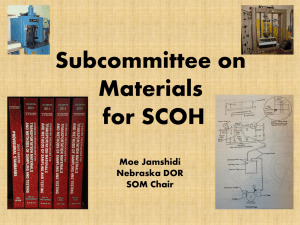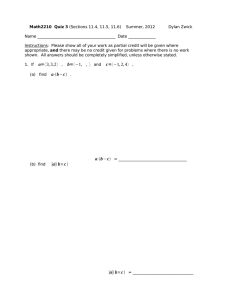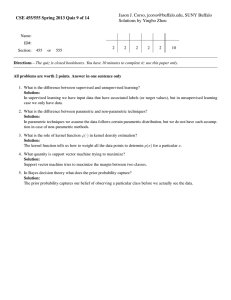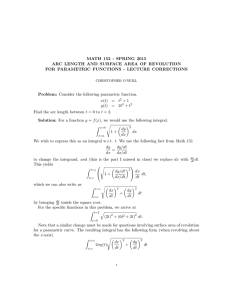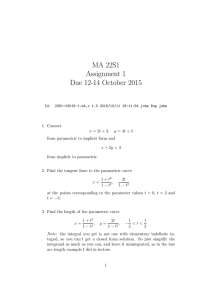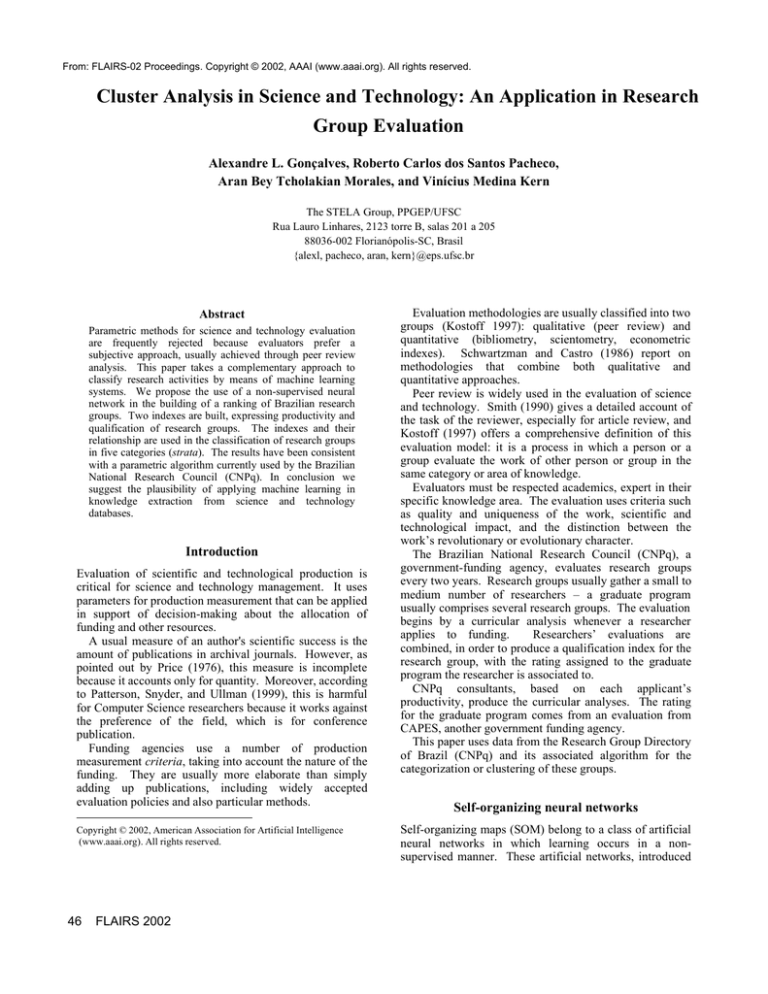
From: FLAIRS-02 Proceedings. Copyright © 2002, AAAI (www.aaai.org). All rights reserved.
Cluster Analysis in Science and Technology: An Application in Research
Group Evaluation
Alexandre L. Gonçalves, Roberto Carlos dos Santos Pacheco,
Aran Bey Tcholakian Morales, and Vinícius Medina Kern
The STELA Group, PPGEP/UFSC
Rua Lauro Linhares, 2123 torre B, salas 201 a 205
88036-002 Florianópolis-SC, Brasil
{alexl, pacheco, aran, kern}@eps.ufsc.br
Abstract
Parametric methods for science and technology evaluation
are frequently rejected because evaluators prefer a
subjective approach, usually achieved through peer review
analysis. This paper takes a complementary approach to
classify research activities by means of machine learning
systems. We propose the use of a non-supervised neural
network in the building of a ranking of Brazilian research
groups. Two indexes are built, expressing productivity and
qualification of research groups. The indexes and their
relationship are used in the classification of research groups
in five categories (strata). The results have been consistent
with a parametric algorithm currently used by the Brazilian
National Research Council (CNPq). In conclusion we
suggest the plausibility of applying machine learning in
knowledge extraction from science and technology
databases.
Introduction
Evaluation of scientific and technological production is
critical for science and technology management. It uses
parameters for production measurement that can be applied
in support of decision-making about the allocation of
funding and other resources.
A usual measure of an author's scientific success is the
amount of publications in archival journals. However, as
pointed out by Price (1976), this measure is incomplete
because it accounts only for quantity. Moreover, according
to Patterson, Snyder, and Ullman (1999), this is harmful
for Computer Science researchers because it works against
the preference of the field, which is for conference
publication.
Funding agencies use a number of production
measurement criteria, taking into account the nature of the
funding. They are usually more elaborate than simply
adding up publications, including widely accepted
evaluation policies and also particular methods.
Copyright © 2002, American Association for Artificial Intelligence
(www.aaai.org). All rights reserved.
46
FLAIRS 2002
Evaluation methodologies are usually classified into two
groups (Kostoff 1997): qualitative (peer review) and
quantitative (bibliometry, scientometry, econometric
indexes). Schwartzman and Castro (1986) report on
methodologies that combine both qualitative and
quantitative approaches.
Peer review is widely used in the evaluation of science
and technology. Smith (1990) gives a detailed account of
the task of the reviewer, especially for article review, and
Kostoff (1997) offers a comprehensive definition of this
evaluation model: it is a process in which a person or a
group evaluate the work of other person or group in the
same category or area of knowledge.
Evaluators must be respected academics, expert in their
specific knowledge area. The evaluation uses criteria such
as quality and uniqueness of the work, scientific and
technological impact, and the distinction between the
work’s revolutionary or evolutionary character.
The Brazilian National Research Council (CNPq), a
government-funding agency, evaluates research groups
every two years. Research groups usually gather a small to
medium number of researchers – a graduate program
usually comprises several research groups. The evaluation
begins by a curricular analysis whenever a researcher
applies to funding.
Researchers’ evaluations are
combined, in order to produce a qualification index for the
research group, with the rating assigned to the graduate
program the researcher is associated to.
CNPq consultants, based on each applicant’s
productivity, produce the curricular analyses. The rating
for the graduate program comes from an evaluation from
CAPES, another government funding agency.
This paper uses data from the Research Group Directory
of Brazil (CNPq) and its associated algorithm for the
categorization or clustering of these groups.
Self-organizing neural networks
Self-organizing maps (SOM) belong to a class of artificial
neural networks in which learning occurs in a nonsupervised manner. These artificial networks, introduced
by Kohonen (1995), resemble biological structures found
in hearing and visual cortex (Pandya et al. 1995). They
have been used for pattern recognition and the
identification of relevant characteristics.
The architecture of a SOM comprises two completely
connected layers. The output or Kohonen layer can be of
one or more dimensions. Training is based on competitive
learning. Output neurons compete with each other to
determine the winner, according to the input. The winner
has its weights updated. The same may happen to its
neighborhood, depending on the distance from the winner.
Weight adjustment is done according to equation 1 or a
variation, where W are the weights between neurons i and
j, η is the learning rate, and x is (the index of) the input
node.
new
Wij
old
old
= W ij + η ( xi – Wij
)
(1)
A Kohonen network creates a map for weight
adjustment from common input nodes to M output nodes
organized in a matrix, usually bi-dimensional, as shown in
fig. 1. A set of vector centers results at the end of this
process, mapping the input space.
A usual method for the determination of the winner
neuron is to minimize the euclidian distance from an input
vector, according to equation 2, where dj is the distance, xi
is the input node, and wij is the weight vector from the
input node i to the output node j. An advantage of this
method, according to Pandya et al. (1995), is that it doesn’t
require weights, or the input vector, to be normalized.
dj = ||xi-wij||
(2)
Another feature of the architecture is the neighborhood
topology, usually rectangular or hexagonal (fig. 1).
Weight adjustment is done in terms of the distance from
the winner. The topology may use, also, a Gauss function
in which the influence of the winner cluster weakens as the
distance increases.
Two other parameters may be considered: the
neighborhood range Ne and the learning rate η. Both can
be considered in terms of time, usually decreasing during
the organization process.
Research group classification according to the
Brazilian National Research Council
The Brazilian National Research Council (CNPq) evaluates
the activity of research groups every two years. The
evaluation is important for research groups’ reputation,
since CNPq is an important agency, and opens
opportunities for funding, although funds allocation is not
officially directed by the evaluation.
Researchers depend, to some extent, on their research
groups’ classification in order to qualify for a research
grant from CNPq or CAPES, another federal funding
agency.
Ne(t1)
Ne(t2)
Ne(t3)
Ne(t1)
Ne(t2)
Ne(t3)
Fig. 1 – Hexagonal and rectangular neighborhood topology
Groups are classified in five strata: from A (top,
excellence) to E. Researchers in groups of stratum A are
usually grantees of CNPq’s productivity grant system.
Their graduate programs are usually best ranked by
CAPES.
Parameters for evaluation
The classification of research groups at CNPq is based on
two indexes: qualification (Q) and productivity (P).
Qualification is a blend of quality levels of each graduate
program (evaluated by CAPES) and their researchers who
are grantees of CNPq, as illustrated by the weights in
tables 1 and 2. The qualification index Q is normalized
with average and standard deviation equal to 50 and 20,
respectively.
CNPq assigns the researcher levels in table 1. Program
levels, in table 2, are assigned by CAPES to graduate
programs in the range [1-7], but only programs with level 3
or more have a pondering weight.
Researcher level
Weight for pondering
1A 1B 1C 2A 2B 2C
1 0.8 0.65 0.55 0.45 0.35
Table 1 – Weights for research group classification
according to researchers’ level (Guimarães et al. 1999)
Program level
Weight for pondering
7
1
6
5
4
3
0.7 0.5 0.35 0.25
Table 2 – Weights for research group classification
according to graduate program level, 1997-98 (Guimarães
et al. 1999)
FLAIRS 2002
47
Productivity is measured in terms of the quantities of
several items produced by each researcher in a two-year
period. Table 3 lists these items and the weights associated
with them. Parameters in tables 1, 2, and 3 are used in the
classification of research groups, described next.
Subset Yij
Nature
i
1
Y1j Journal papers
2
3
4
5
Y2j Conference papers
and others
Type Tij
11-National
12-International
21-Full
22-Journal w/out
editorial body
23-Technical mag.
24-Abstract
Y3j Books and chapters 31-Book
32-Chapter
Y4j Technological items 41-Software
42-Techn. product
43-Process
Y5j Defenses (advising) 51-Doctoral
52-Masters
Weight
v
0.3
0.7
0.5
0.2
0.2
0.1
0.7
0.3
0.33
0.33
0.33
0.7
0.3
Table 3 – Weights for research group classification
according to researchers’ production (Guimarães et al.
1999)
Classification using current algorithm and SOM
approaches
This section describes the evaluation of research groups
using an algorithm developed by CNPq, and a neural
network (SOM) approach for this evaluation. The SOM
approach is implemented in parametric and non-parametric
versions, i.e., using or not the parameters in tables 1 to 3.
We apply the SOM approach to data of Engineering and
Computing research groups. In a first stage we build a
classification according to both versions of the SOM. In a
second stage, we compare the results given by the
networks with the ones given by CNPq (Guimarães et al.
1999).
Two networks are built: one for the calculation of
qualification, one for the calculation of productivity.
The P-SOM. The Productivity SOM (P-SOM) uses
quantitative data from table 3. Equation 3, from CNPq’s
classification algorithm (Guimarães et al. 1999), was used
for input data normalization. Yi is the productivity
measure for the i-th subset, Tij is the type of work, v is the
associated weight, and n is the number of doctors in the
research group.
Y=
Σ
√ n
Tj * v
log 1 + _______
(3)
The parametric version of P-SOM uses weights from
table 3. The non-parametric version uses v=1. These are
input data for the network, allowing for the building of a
weight matrix for the calculation of P. The preliminary
48
FLAIRS 2002
productivity index is given by equation 4, where Ui is a
non-normalized productivity measure and the remaining
symbols have the same meaning that in equations 1-3.
Σ Y ij + w ij
Ui = ____________
(4)
x
A normalized index z, in the interval [-2.5; 2.5], is built
from U using equation 5 (Guimarães et al. 1999). Finally,
the normalized productivity P is given by equation 6
(Guimarães et al. 1999).
Ui – µ (U)
zi = _________
σ(U)
(5)
Pi = 50 + 20 zi
(6)
The Q-SOM. The Qualification SOM (Q-SOM) uses
qualitative data from tables 1 and 2. We used equations 7
and 8 for normalization (Guimarães et al. 1999), where bj
is the number of doctors who are researchers and grantees
of CNPq, dj is the number of doctors in graduate programs
with level equal or greater than 3 (see table 2), n is the
number of doctors in each graduate program, and v and w
are weights according to tables 1 and 2 (for the parametric
version), or v,w=1 (for the non-parametric version).
bj * w
Bi = _______
n
dj * v
Di = ______
n
(7)
(8)
The preliminary qualification index is given by equation
9, where Xi is a non-normalized qualification measure and
the remaining symbols have the same meaning that in
previous equations.
Σ Y ij + w ij
Xi = ____________
(9)
x
A normalized index z, in the interval [-2.5; 2.5], is built
from X using equation 10 (Guimarães et al. 1999).
Finally, the normalized qualification Q is given by
equation 11 (Guimarães et al. 1999).
Xi – µ (X)
zi = _________
(10)
Qi = 50 + 20 zi
(11)
σ(X)
Results
Fig. 2 shows the distribution of P and Q values for both
versions (parametric and non-of parametric) of the SOM,
and the distribution from the algorithm of CNPq
(Guimarães et al. 1999). According to the algorithm, the
distribution is organized in classes for Q intervals of 5 –
the first class is related to research groups with Q < 20, the
top class comprises research groups with Q > 85, adding
up to 15 classes.
Results from the SOM
(non-parametric)
Stratum
80
A
B
C
D
E
total
70
(P) 60
50
40
30
0
10
20 30
40
50
60
70 80
90 100
Results from the SOM
(parametric)
Groups Groups (non- Ratio
Groups
Ratio
(algorithm) parametric) n.-p. / (parametric) p. /
alg.
alg.
102
113
1.11
102
1
304
277
0.91
304
1
319
333
1.04
315
0.99
192
187
0.97
195
1.02
238
245
1.03
239
1
1155
1155
1155
Table 5 – Number of Engineering and Computing research
groups in the SOM approach, and ratio in relation to the
original parametric algorithm (non-parametric and
parametric versions)
80
Table 5 shows a comparison of number of groups in
each category, comparing the results of the SOM approach
to those of CNPq. Tables 6 and 7 display a comparison of
number of groups in each category compared to those with
same classification by CNPq.
70
(P) 60
50
40
Stratum
30
0
10 20
30
40
50 60
(Q)
70
80 90 100
A
B
C
D
E
Results from the CNPq algorithm
80
70
total
(P) 60
50
71
213
217
75
194
770
Groups
(algorithm)
102
304
315
195
239
1155
Percentage
ratio
69,6
70,1
68,0
39,1
81,5
66,7
Table 6 – Engineering and Computing research groups
classified by the SOM, non-parametric version, compared
to groups with same classification by the original algorithm
40
30
0
10 20
30
40
50 60
(Q)
70
80 90 100
Fig. 2 – Distribution of P and Q indexes for Engineering
and Computing research groups according to the SOM
approach, non-parametric and parametric, and to the CNPq
classification
As a general trend, it is possible to observe a positive
correlation between P and Q. However, the SOM nonparametric analysis show some classes that don’t follow
that trend. This is due to the fact that the network does not
consider different weights for the parameters.
Table 4 presents the classification of research groups in
five categories according to the criterion of CNPq. The
categories are formed according to decile intervals of Q.
The classification is performed for the three measures in
fig. 3.
Stratum
Interval
Groups (nonparametric)
A
≥D9
B
C
D
D6 to <D 9 D3 to <D 6 D1 to <D3
E
< D1
Table 4 – Research group categories (strata) according to
classification intervals (deciles) (Guimarães et al. 1999)
Stratum
A
B
C
D
E
total
Groups
(parametric)
87
263
274
165
227
1016
Groups
(algorithm)
102
304
315
195
239
1155
Percentage
ratio
85,3
86,5
85,9
85,9
95,4
88,0
Table 7 – Engineering and Computing research groups
classified by the SOM, parametric version, compared to
groups with same classification by the original algorithm
The percentage of 66,7% of the non-parametric SOM
indicates that it is useful for a preliminary study – for
instance, for the establishment of weights. The parametric
version reached a coincidence of 88%, very significant if
we consider that in several cases the index was very close
to the frontier of the correct (coincident) category.
Lastly, tables 8 and 9 exhibit the detailed comparison of
each version of the SOM with the CNPq algorithm. The
bold numbers show the coincident classifications.
Focusing on the SOM classification as category C, for
instance, from 333 groups classified as C by the nonparametric version, 217 were coincident with the original
FLAIRS 2002
49
NP Alg
A
B
C
D
E
total
A
71
29
0
0
0
102
B
42
213
33
16
0
304
C
0
35
217
52
15
319
D
0
0
81
75
36
192
E
0
0
0
11
227
238
total
113
277
333
187
245
1155
Table 8 – Distribution of research groups classified by the
SOM, non-parametric version (NP), compared to the
classification by the original algorithm (Alg)
P
Alg
A
B
C
D
E
total
A
87
15
0
0
0
102
B
15
263
26
0
0
304
C
0
26
274
19
0
319
D
0
0
15
165
12
192
E
0
0
0
11
227
238
total
102
304
315
195
239
1155
Table 9 – Distribution of research groups classified by the
SOM, parametric version (P), compared to the
classification by the original algorithm (Alg)
algorithm, 81 were assigned to category D, 33 to category
B, and 2 to category A. Similarly, the parametric version
classified 315 groups as C, with 274 coincidences,
assigning the remaining groups as 26 B and 15 D.
Conclusion
This paper presented an approach to research group
evaluation based on automatic analysis using selforganizing maps. Self-organizing maps were briefly
explained. The framework for research group evaluation
of a Brazilian agency was outlined. This parametric
evaluation measures research groups’ productivity and
qualification, and classify them in five categories.
A neural network approach to this evaluation was
introduced, using two different networks for productivity
and qualification measures.
Each network was
implemented in two versions: parametric and nonparametric.
The neural network approach resulted in a consistent
evaluation when compared to the results produced using
the agency’s framework, with better results using the
parametric version. This is due to invariance of weights of
the non-parametric version. One strategy to improve the
performance of the non-parametric evaluation could be the
use, in a first stage, of a supervised network for the
assignment of weights for input data normalization.
We consider these results satisfactory, but preliminary.
In this stage we have the confirmation of results of wellestablished parametric algorithms. Further research is
recommended, especially dealing with data normalization,
similarity metrics, and data evaluation.
The results so far have opened new perspectives for
machine learning application in science and technology
50
FLAIRS 2002
databases. Considering that the results were consistent, it
is plausible that we can apply machine learning in
knowledge extraction from science and technology
databases. Romão (2002) recently advanced in this
direction, applying a fuzzy genetic algorithm for the
discovery of interesting knowledge in science and
technology databases.
Acknowledgments
This research was supported in part by CAPES, Brazil, in
the form of a scholarship held by Mr. Gonçalves during his
mastering.
References
Guimarães, R., Galvão, G., Cosac, S. M., Lourenço, R. S.
et al. 1999. A pesquisa no Brasil: Perfil da pesquisa no
Brasil e hierarquização dos grupos de pesquisa a partir dos
dados do Diretório dos Grupos de Pesquisa no Brasil.
Technical Report, CNPq (Brazilian National Research
Council).
Johnson, R. A., Wichern, D. W. 1995. Applied
multivariate statistical analysis, 4th ed. New Jersey:
Prentice-Hall.
Kohonen, T. 1995. Self-organizing maps. Heidelberg,
Germany: Springer Series in Information Sciences.
Kostoff, R. N. 2000. Research program peer review:
Principles, practices, protocols. 1997. [Available on-line at
http://www.dtic.mil/dtic/kostoff/index.html. Acess
2000.02.02]
Medler, D. A. 1998. A brief history of connectionism.
Department of Psychology, University of Alberta, Alberta,
Canada. Neural Computing Survey 1:61-101. [Available
on-line at
http://www.icsi.berkeley.edu/~jagota/NCS/vol1.html.
Acess 2000.02.02]
Pandya, A. S., Macy, R. B. 1995. Pattern recognition with
neural networks in C++. Boca Raton, Fla.: CRC Press,
Florida Atlantic University.
Patterson, D., Snyder, L. and Ullman, J. 1999. Best
practices memo: evaluating computer scientists and
engineers for promotion and tenure. Computing Research
News, p. A-B, Sept. 1999. Special insert.
Price, D. J. de S. 1976. O desenvolvimento da ciência:
análise histórica, filosófica, sociológica e econômica. Rio
de Janeiro, Brazil: Livros Técnicos e Científicos.
Romão, W. 2002. Descoberta de conhecimento relevante
em bancos de dados sobre ciência e tecnologia. Doctoral
thesis, Universidade Federal de Santa Catarina (Brazil),
Programa de Pós-Graduação em Engenharia de Produção.
[To be available at http://teses.eps.ufsc.br]
Schwartzman, S., and Castro, C. M. 1986. Pesquisa
universitária em questão. Rio de Janeiro, Brazil: Ícone.
Smith, A.J. (1990) The task of the referee, IEEE Computer
23 (4):46-51, April 1990.

